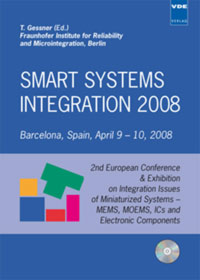Planarity Optimization of Spatial Light Modulators
Conference: Smart Systems Integration 2008 - 2nd European Conference & Exhibition on Integration Issues of Miniaturized Systems - MOMS, MOEMS, ICS and Electronic Components
04/09/2008 - 04/10/2008 at Barcelona, Spain
Proceedings: Smart Systems Integration 2008
Pages: 3Language: englishTyp: PDF
Personal VDE Members are entitled to a 10% discount on this title
Authors:
Duerr, Peter; Wolschke, Steffen; Ludewig, Thomas; Dauderstädt, Ulrike; Kunze, Detlef; Wagner, Michael; Lakner, Hubert (Fraunhofer Institut Photonische Mikrosysteme (IPMS), Maria-Reiche-Str. 2, 01109 Dresden (Germany)
Abstract:
Micro-machined spatial light modulators (SLMs) can be used in various applications such as micro lithography and adaptive optics. Fraunhofer IPMS has a very long experience in developing such devices. Ideally, the optically active surface area of the SLMs would be completely flat when not actuated. In reality, the SLM chip might be slightly bent and/or warped and the surface might show hills and valleys on various lateral length-scales due to fabrication imperfections. This surface profile is very hard to avoid in typical fabrication and mounting processes and can degrade the overall performance of the SLM in critical applications. Adjusting the shape by piezo-actuator arrays, would be a possible solution, but a very complex and expensive one. An array of screws acting on the SLM is too coarse to be a suitable method for adjusting the flatness properly for optical surface quality. An additional drawback of both above ways to improve the planarity is that it is difficult to get rid of the heat generated in the SLM during operation.


